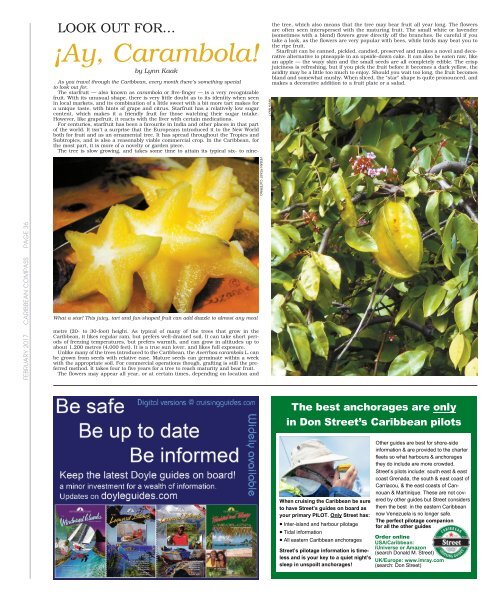Caribbean Compass Yachting Magazine February 2017
Welcome to Caribbean Compass, the most widely-read boating publication in the Caribbean! THE MOST NEWS YOU CAN USE - feature articles on cruising destinations, regattas, environment, events...
Welcome to Caribbean Compass, the most widely-read boating publication in the Caribbean! THE MOST NEWS YOU CAN USE - feature articles on cruising destinations, regattas, environment, events...
Create successful ePaper yourself
Turn your PDF publications into a flip-book with our unique Google optimized e-Paper software.
LOOK OUT FOR…<br />
¡Ay, Carambola!<br />
by Lynn Kaak<br />
LYNN KAAK<br />
the tree, which also means that the tree may bear fruit all year long. The flowers<br />
are often seen interspersed with the maturing fruit. The small white or lavender<br />
(sometimes with a blend) flowers grow directly off the branches. Be careful if you<br />
take a look, as the flowers are very popular with bees, while birds may beat you to<br />
the ripe fruit.<br />
Starfruit can be canned, pickled, candied, preserved and makes a novel and decorative<br />
alternative to pineapple in an upside-down cake. It can also be eaten raw, like<br />
an apple — the waxy skin and the small seeds are all completely edible. The crisp<br />
juiciness is refreshing, but if you pick the fruit before it becomes a dark yellow, the<br />
acidity may be a little too much to enjoy. Should you wait too long, the fruit becomes<br />
bland and somewhat mushy. When sliced, the “star” shape is quite pronounced, and<br />
makes a decorative addition to a fruit plate or a salad.<br />
VEGAN FEAST CATERING<br />
FEBRUARY <strong>2017</strong> CARIBBEAN COMPASS PAGE 36<br />
What a star! This juicy, tart and fun-shaped fruit can add dazzle to almost any meal<br />
As you travel through the <strong>Caribbean</strong>, every month there’s something special<br />
to look out for.<br />
The starfruit — also known as carambola or five-finger — is a very recognizable<br />
fruit. With its unusual shape, there is very little doubt as to its identity when seen<br />
in local markets, and its combination of a little sweet with a bit more tart makes for<br />
a unique taste, with hints of grape and citrus. Starfruit has a relatively low sugar<br />
content, which makes it a friendly fruit for those watching their sugar intake.<br />
However, like grapefruit, it reacts with the liver with certain medications.<br />
For centuries, starfruit has been a favourite in India and other places in that part<br />
of the world. It isn’t a surprise that the Europeans introduced it to the New World<br />
both for fruit and as an ornamental tree. It has spread throughout the Tropics and<br />
Subtropics, and is also a reasonably viable commercial crop. In the <strong>Caribbean</strong>, for<br />
the most part, it is more of a novelty or garden piece.<br />
The tree is slow growing, and takes some time to attain its typical six- to ninemetre<br />
(20- to 30-foot) height. As typical of many of the trees that grow in the<br />
<strong>Caribbean</strong>, it likes regular rain, but prefers well-drained soil. It can take short periods<br />
of freezing temperatures, but prefers warmth, and can grow in altitudes up to<br />
about 1,200 metres (4,000 feet). It is a true sun lover, and likes full exposure.<br />
Unlike many of the trees introduced to the <strong>Caribbean</strong>, the Averrhoa carambola L. can<br />
be grown from seeds with relative ease. Mature seeds can germinate within a week<br />
with the appropriate soil. For commercial operations though, grafting is still the preferred<br />
method. It takes four to five years for a tree to reach maturity and bear fruit.<br />
The flowers may appear all year, or at certain times, depending on location and<br />
The best anchorages are only<br />
in Don Street’s <strong>Caribbean</strong> pilots<br />
When cruising the <strong>Caribbean</strong> be sure<br />
to have Street’s guides on board as<br />
your primary PILOT. Only Street has:<br />
Inter-island and harbour pilotage<br />
Tidal information<br />
All eastern <strong>Caribbean</strong> anchorages<br />
Street’s pilotage information is timeless<br />
and is your key to a quiet night’s<br />
sleep in unspoilt anchorages!<br />
Other guides are best for shore-side<br />
information & are provided to the charter<br />
fleets so what harbours & anchorages<br />
they do include are more crowded.<br />
Street’s pilots include: south east & east<br />
coast Grenada, the south & east coast of<br />
Carriacou, & the east coasts of Cannouan<br />
& Martinique. These are not covered<br />
by other guides but Street considers<br />
them the best in the eastern <strong>Caribbean</strong><br />
now Venezuela is no longer safe.<br />
The perfect pilotage companion<br />
for all the other guides<br />
Order online<br />
USA/<strong>Caribbean</strong>:<br />
iUniverse or Amazon<br />
(search Donald M. Street)<br />
UK/Europe: www.imray.com<br />
(search: Don Street)


















